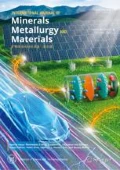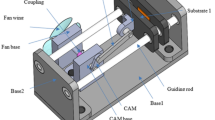Abstract
Hydrogen is a promising renewable energy source for fossil-free transportation and electrical energy generation. However, leaking hydrogen in high-temperature production processes can cause an explosion, which endangers production workers and surrounding areas. To detect leaks early, we used a sensor material based on a wide bandgap aluminum nitride (AlN) that can withstand a high-temperature environment. Three unique AlN morphologies (rod-like, nest-like, and hexagonal plate-like) were synthesized by a direct nitridation method at 1400°C using γ-AlOOH as a precursor. The gas-sensing performance shows that a hexagonal plate-like morphology exhibited p-type sensing behavior and showed good repeatability as well as the highest response (S = 58.7) toward a 750 ppm leak of H2 gas at high temperature (500°C) compared with the rod-like and nest-like morphologies. Furthermore, the hexagonal plate-like morphology showed fast response and recovery times of 40 and 82 s, respectively. The surface facet of the hexagonal morphology of AlN might be energetically favorable for gas adsorption-desorption for enhanced hydrogen detection.
Similar content being viewed by others
References
G.W. Crabtree, M.S. Dresselhaus, and M.V. Buchanan, The hydrogen economy, Phys. Today, 57(2004), No. 12, p. 39.
J.Y. Kim, A. Jun, O. Gwon, S.Y. Yoo, M.L. Liu, J.Y. Shin, T.H. Lim, and G. Kim, Nano energy hybrid-solid oxide electrolysis cell: A new strategy for efficient hydrogen production, Nano Energy, 44(2018), p. 121.
O. Lupan, G.Y. Chai, and L. Chow, Novel hydrogen gas sensor based on single ZnO nanorod, Microelectron. Eng., 85(2008), No. 11, p. 2220.
H.S. Gu, Z. Wang, and Y.M. Hu, Hydrogen gas sensors based on semiconductor oxide nanostructures, Sensors, 12(2012), No. 5, p. 5517.
C.X. Wang, L.W. Yin, L.Y. Zhang, D. Xiang, and R. Gao, Metal oxide gas sensors: Sensitivity and influencing factors, Sensors, 10(2010), No. 3, p. 2088.
A. Hermawan, Y. Asakura, M. Kobayashi, M. Kakihana, and S. Yin, High temperature hydrogen gas sensing property of GaN prepared from a-GaOOH, Sens. ActuatorsB, 276(2018), p. 388.
B.S. Kang, H.T. Wang, L.C. Tien, F. Ren, B.P. Gila, D.P. Norton, C.R. Abernathy, J.S. Lin, and S.J. Pearton, Wide bandgap semiconductor nanorod and thin film gas sensors, Sensors, 6(2006), No. 6, p. 643.
F. Ren and S.J. Pearton, Recent advances in wide bandgap semiconductor-based gas sensors, [in] R. Jaaniso and O.K. Tan eds., Semiconductor Gas Sensors, 2013, p. 159.
S. Yin, Creation of advanced optical responsive functionality of ceramics by green processes, J. Ceram. Soc. Jpn., 123(2015), No. 1441, p. 823.
T. Singh and E. Kohn, Harsh environment materials, Ref. Module Mater. Sci. Mater. Eng. (2016). DOI: https://doi.org/10.1016/b978-0-12-803581-8.09253-5
S. Yin and Y. Asakura, Recent research progress on mixed valence state tungsten based materials, Tungsten, 1(2019), No. 1, p. 5.
X.Y. Huang, P.K. Jiang, and T. Tanaka, A review of dielectric polymer composites with high thermal conductivity, IEEE Electr. Insul. Mag., 27(2011), No. 4, p. 8.
J. Beheshtian, M.T. Baei, Z. Bagheri, and A.A. Peyghan, AlN nanotube as a potential electronic sensor for nitrogen dioxide, Microelectron. J., 43(2012), No. 7, p. 452.
A. Dey, Semiconductor metal oxide gas sensors: A review, Mater. Sci. Eng. B, 229(2018), p. 206.
A. Hermawan, H. Son, Y. Asakura, T. Mori, and S. Yin, Synthesis of morphology controllable aluminum nitride by direct nitridation of y-AlOOH in the presence of N2H4 and their sintering behavior, J. Asian Ceram. Soc., 6(2018), No. 1, p. 63.
A. Hermawan, Y. Asakura, M. Inada, and S. Yin, One-step synthesis of micro-/mesoporous SnO2 spheres by solvothermal method for toluene gas sensor, Ceram. Int., 45(2019), No. 12, p. 15435.
X.M. Sun, X. Chen, Z.X. Deng, and Y.D. Li, A CTAB-assisted hydrothermal orientation growth of ZnO nanorods, Mater. Chem. Phys., 78(2003), No. 1, p. 99.
C. Bullen, P. Zijlstra, E. Bakker, M. Gu, and C. Raston, Chemical kinetics of gold nanorod growth in aqueous CTAB solutions, Cryst. Growth Des., 11(2011), No. 8, p. 3375.
R. Wahab, Y.S. Kim, and H.S. Shin, Synthesis, characterization and effect of pH variation on zinc oxide nanostructures, Mater. Trans., 50(2009), No. 8, p. 2092.
P. Sivakumar, M. Jana, M.G. Jung, A. Gedanken, and H.S. Park, Hexagonal plate-like Ni-Co-Mn hydroxide nanotfructures to achieve high energy density of hybrid supercapacitors, J. Mater. Chem. A, 7(2019), No. 18, p. 11362.
B.D. Liu, Y. Bando, A.M. Wu, X. Jiang, B. Dierre, T. Sekiguchi, C.C. Tang, M. Mitome, and D. Golberg, 352 nm ultraviolet emission from high-quality crystalline AlN whiskers, Nanotechnology, 21(2010), No. 7, art. No. 75708.
A. Singh, H. Bae, T. Hussain, H. Watanabe, and H.Y. Lee, Efficient sensing properties of aluminum nitride nanosheets toward toxic pollutants under gated electric field, ACS Appl. Electron. Mater., 2(2020), No. 6, p. 1645.
C.C. Li, H.G. Zhou, S.C. Yang, L.Y. Wei, Z.Z. Han, Y.F. Zhang, and H.B. Pan, Preadsorption of O2 on the exposed (001) facets of ZnO nanostructures for enhanced sensing of gaseous acetone, ACS Appl. Nano Mater., 2(2019), No. 10, p. 6144.
L. Rosenberger, R. Baird, E. Mccullen, G. Auner, and G. Shreve, XPS analysis of aluminum nitride films deposited by plasma source molecular beam epitaxy, Surf. Interface Anal., 40(2008), No. 9, p. 1254.
D. Manova, V. Dimitrova, W. Fukarek, and D. Karpuzov, Investigation of d.c.-reactive magnetron-sputtered AlN thin films by electron microprobe analysis, X-ray photoelectron spectroscopy and polarised infra-red reflection, Surf. Coat. Technol., 106(1998), No. 2–3, p. 205.
T. Yamamoto and H. Katayama-Yoshida, Effects of oxygen incorporation in p-type AlN crystals doped with carbon species, PhysicaB, 273–274(1999), p. 113.
R.Q. Wu, L. Shen, M. Yang, Z.D. Sha, Y.Q. Cai, Y.P. Feng, Z.G. Huang, and Q.Y. Wu, Possible efficient p-type doping of AlN using Be: An ab initio study, Appl. Phys. Lett., 91(2007), No. 15, art. No. 152110.
G. Saito, Y. Kunisada, T. Watanabe, X.M. Yi, T. Nomura, N. Sakaguchi, and T. Akiyama, Combustion synthesis of AlN doped with carbon and oxygen, J. Am. Ceram. Soc., 102(2019), No. 1, p. 524.
O.T. Özkan and A.J. Moulson, The electrical conductivity of single-crystal and polycrystalline aluminium oxide, J. Phys. D. Appl. Phys., 3(1970), No. 6, p. 983.
S.P.S. Badwal, Electrical conductivity of single crystal and polycrystalline yttria-stabilized zirconia, J. Mater. Sci., 19(1984), No. 6, p. 1767.
G.S. Devi, T. Hyodo, Y. Shimizu, and M. Egashira, Synthesis of mesoporous TiO2-based powders and their gas-sensing properties, Sens. Actuators B, 87(2002), No. 1, p. 122.
Y.V. Kaneti, Z.J. Zhang, J. Yue, Q.M.D. Zakaria, C.Y. Chen, X.C. Jiang, and A.B. Yu, Crystal plane-dependent gas-sensing properties of zinc oxide nanostructures: Experimental and theoretical studies, Phys. Chem. Chem. Phys., 16(2014), No. 23, p. 11471.
J.J. Chen, J.D. Zhang, M.M. Wang, and Y. Li, High-temperature hydrogen sensor based on platinum nanoparticle-decorated SiC nanowire device, Sens. Actuators B, 201(2014), p. 402.
C. Lu and Z. Chen, High-temperature resistive hydrogen sensor based on thin nanoporous rutile TiO2 film on anodic aluminum oxide, SensActuators B, 140(2009), No. 1, p. 109.
M. Ali, V. Cimalla, V. Lebedev, H. Romanus, V. Tilak, D. Merfeld, P. Sandvik, and O. Ambacher, Pt/GaN Schottky diodes for hydrogen gas sensors, Sens. Actuators B, 113(2006), No. 2, p. 797.
C. Wildfire, E. Çiftyürek, K. Sabolsky, and E.M. Sabolsky, Investigation of doped-gadolinium zirconate nanomaterials for high-temperature hydrogen sensor applications, J. Mater. Sci, 49(2014), No. 14, p. 4735.
H.J. Kim and J.H. Lee, Highly sensitive and selective gas sensors using p-type oxide semiconductors: Overview, Sens. Actuators B, 192(2014), p. 607.
P. Strak, K. Sakowski, P. Kempisty, I. Grzegory, and S. Krukowski, Adsorption of N2 and H2 at AlN(0001) surface: Ab initio assessment of the initial stage of ammonia catalytic synthesis, J. Phys. Chem. C, 122(2018), No. 35, p. 20301.
Q. Wang, Q. Sun, P. Jena, and Y. Kawazoe, Potential of AlN nanostructures as hydrogen storage materials, ACS Nano., 3(2009), No. 3, p. 621.
Acknowledgements
This work was financially support by the Japan Society for the Promotion of Science (JSPS) Grant-in-Aid for Scientific Research (KAKENHI) (No. 20H00297 and Innovative Areas No. JP16H06439) and the Cooperative Research Program of Dynamic Alliance for Open Innovations Bridging Human, Environment and Materials in the “Network Joint Research Center for Materials and Devices”.
Author information
Authors and Affiliations
Corresponding author
Rights and permissions
About this article
Cite this article
Hermawan, A., Asakura, Y. & Yin, S. Morphology control of aluminum nitride (AlN) for a novel high-temperature hydrogen sensor. Int J Miner Metall Mater 27, 1560–1567 (2020). https://doi.org/10.1007/s12613-020-2143-8
Received:
Revised:
Accepted:
Published:
Issue Date:
DOI: https://doi.org/10.1007/s12613-020-2143-8




